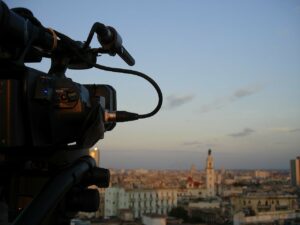Film as Pedagogy
By 2021 - 22 CITLS Distinguished Teaching Fellow, Professor Nandini Sikand
Goal
To describe how instructors can use film as a pedagogical tool in the classroom to generate discussions around bias and inequities.
Overview
Film, especially documentary cinema, is often misunderstood to be transparent and objective, and common sense notions such as “the camera doesn’t lie” can be a misleading assumption for students and educators. In this regard, film can be used as a tool in classrooms to reveal biases and foster discussion around issues of equity and inclusion. This resource helps instructors generate discussions around:
- What it means to use visual media in the classroom, sometimes assumed to be value-neutral, and
- The implications of the fraught use of violent images, aspects of cinematic language, and what students can learn about (mis)reading a film and/or an image
Recommendations
When viewing images, invite students to consider both the content, what is in the frame, and the context, what is outside of the frame. Specifically, when students watch the film, ask them to analyze the aspects noted below and to share their observations.
Content
- Camera and camera angles: Where is the camera? Is it moving or stationary?
- Framing: Who/what is in the frame? Who/what is outside the frame?
- Lighting: What does the lighting suggest?
- Sound/Sound Effects: Is music being used? Why and what kind? What is its job in the scene?
- Actors/Speakers : Who is speaking and why? Whose voice is missing?
- Narration: Who is the narrator? Why do you think this person is narrating? What is their tone?
- Editing: What are the transitions between shots? When and why does the camera cut away?
- Props: What are the things we see? Why are they in the frame?
Context
- Who is the author? Is there more than one?
- How was it made/funded? Who might benefit from this media/film?
- What is outside the frame? Who and what is missing?
- Who is speaking for whom? Which social actors are not present?
- What is the historical and political context of these images?
- Are there other sources of information about this subject?
- Do the images enact familiar tropes?
- And what is beyond the frame?
Example
Born Into Brothels is a documentary film about the children of sex workers in a red light district in Kolkata, India. I used this film in a course and students analyzed it using the questions above. The content and context questions were relatively easy to implement and worked well to signal to students my commitment to their success in analyzing the documentary.
In the piece referenced below I make comparisons between Born into Brothels and a film I produced, Soma Girls, which paints a different story of the families of the children living in brothels. By answering the questions above, students can generate similar observations of the film.
